Nintendo Switch vs Xbox One and PS4 – How do they compare?
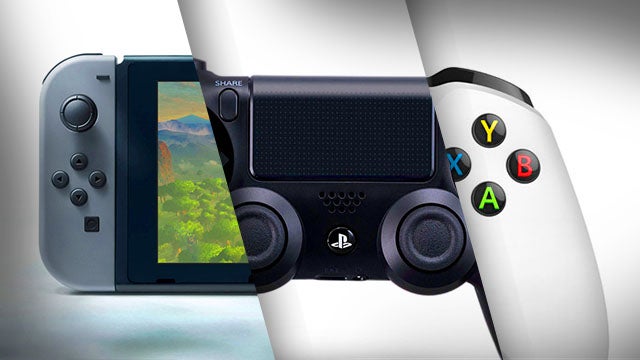
Nintendo Switch vs PS4 and Xbox One: How does Nintendo’s console stack up to its rivals? We compare all the specs, controllers, hardware, features and games.
The Nintendo Switch is unlike any other console on the market. Taking HD gaming and putting it in your pocket, there are some serious technical achievements. But how does it compare to its competitors, and what can you expect in terms of performance? Here, we look at the Switch alongside the PS4 and Xbox One.
Before we get started, it’s worth pointing out that this article is not intended to help decide which is better, but instead explain how the Switch differs.
Related: Amazon Prime Day 2019
How the Nintendo Switch works
To make sure we’re all on the same page, it’s worth taking a moment to explain how the Switch works. You can read more details in our Switch review, but here’s its main functionality in a few bullet points:
- Main console is a 6.2-inch 1,280 x 720-pixel touchscreen unit, controlled by two detachable Joy-Con controllers that dock to either side
- Between 2.5 and 6 hours of battery life when gaming
- Console can be docked, outputting games to your TV. Joy-Cons instead connect to Joy-Con Grip for wireless play
- Joy-Cons can also be used separately by two players for simpler games or games that use multiplayer motion controls
- More traditional “Pro” controller sold separately
- Up to eight consoles can connect wirelessly for local multiplayer
Related: Upcoming Nintendo Switch Games 2017
Now we’re up to speed, let’s head to the comparisons.
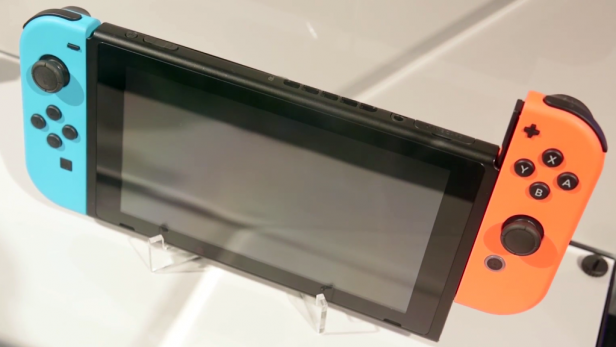
Nintendo Switch vs PS4 and Xbox One – Controllers
Nintendo has made the controllers on the Switch unlike anything we’ve seen before. Let’s take a look at how a pair of Joy-Con controllers and the Pro controller compare to Sony and Microsoft’s offerings.
| Feature | Joy-Con pair | Switch Pro | Xbox One | PS4 | PS4 Move pair |
|---|---|---|---|---|---|
| Control buttons | 18 touchscreen | 18 | 17 | 17 touch | 18 |
| Analogue sticks | 2 | 2 | 2 | 2 | 2 |
| Vibration | Yes | Yes | Yes | Yes | Yes |
| Wireless | Yes | Yes | Yes | Yes | Yes |
| Battery capacity | 525mAh (each) | 1300mAh | N/A | 1000mAh | 1520mAh (each) |
| Battery life | 20h (official) | 40h (official) | Variable | ~7 h | ~10h |
| Motion controls | Yes | Yes | No | Yes | Yes |
| IR camera | Yes | No | No | No | No |
| Removable batteries*** | No | No | Yes | No | No |
| Play and charge | Yes* | Yes | Yes** | Yes | Yes |
| Headphone jack | No | No | Yes | Yes | No |
* With optional Charge Grip
** Play-and-charge kit available
*** Without voiding warranty
A table can’t explain all the differences between the controllers. For example, the rumble feedback in the Joy-Con controllers is described as “HD”, with extremely precise motors that let you feel very subtle movements. This will come in handy in motion-controlled games and the rumoured VR headset.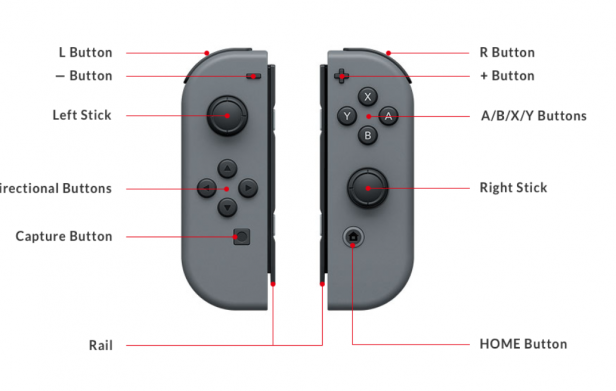
The way the Joy-Cons charge is much more confusing than simply connecting over USB. Connected to the screen, the controllers are powered so don’t need to use their own battery. To charge them properly, you’ll need to dock the console and attach the controllers to it. That way, the console and controllers all charge at the same time.
Considering the Joy-Con can go 20+ hours between charges, this shouldn’t be a big problem. If you think it will be, you can pick up a Charge Grip for £24.99. You’ll be able to trail a cable from your console (or a wall plug) and charge the Joy-Con while still playing.
Related: Best Nintendo Switch Games
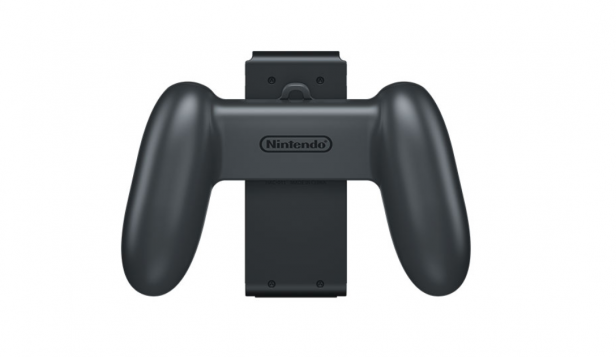
It’s important not to forget PlayStation Move controllers here, which is why we’ve included them in the comparison table. The Move is technically quite different; it needs to be within view of a sensor in order to deliver spatially accurate motion controls. The Switch doesn’t work like this, and therefore doesn’t have the same spatially accurate movements.
The right-side Joy-Con also includes an infrared sensor for detecting objects and motion, and also includes and NFC chip for detecting Amiibo characters.
Nintendo Switch vs PS4 and Xbox One – Specs and Graphics
Here’s the bit the techies were waiting for. Let’s run down the raw specifications of the three consoles.
| Feature | Switch* | Xbox One** | PS4** |
|---|---|---|---|
| CPU: Cores | 4x ARM Cortex A57 | 8x AMD Jaguar | 8x AMD Jaguar |
| CPU: Clock speed | 1020MHz | 1,750MHz | 1,600MHz |
| GPU: Cores | 256 Nvidia CUDA | 768x AMD Shaders | 1152 AMD shaders |
| GPU: Docked speed | 768MHz | 853MHz | 800MHz |
| GPU: Undocked speed | 307.2MHz | N/A | N/A |
| HDR | No? | Yes (One S) | Yes |
| Memory | 4GB | 8GB | 8GB |
| Storage | 32GB flash (microSD-expandable) | 500GB HDD | 500GB HDD |
| Physical game formats | Game Card | Disc | Disc |
| USB ports | 2x USB2, 1x USB3.0 | 3x USB 3.0 | 2x USB 3.1 (gen1) |
| Video output | HDMI | HDMI | HDMI (HDR supported) |
| Audio ports | None | Optical | Optical |
| Networking ports | None | Gigabit Ethernet | Gigabit Ethernet |
| Power consumption | Unknown | ~125W | ~140W |
* CPU and GPU specs are non-official, based on reports including those from Digital Foundry
** For simplicity, these are Original PS4 and Xbox One rather than updated PS4 Pro/Slim and Xbox One S
Let’s look at the top five rows first. It’s not surprising to see that the Switch has a considerably lower processor speed, fewer processor cores, fewer GPU shaders and a lower GPU clock speed. This is a tiny machine, after all.
Related: Nintendo Switch battery life – is it enough?
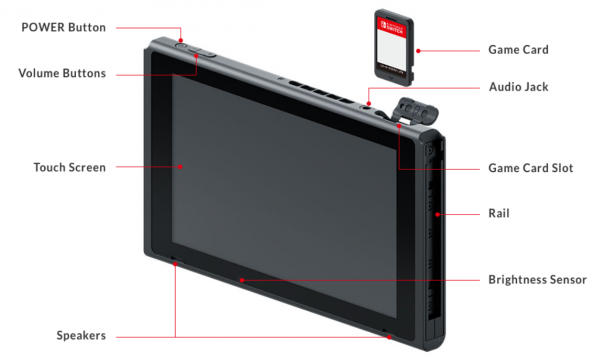
To the uninitiated, these numbers will be confusing and make the Switch look like a piddly little machine. Rest assured that the Nvidia tech that powers this is genuinely remarkable. Consider this: the CPU and GPU in the Switch, which is based on the Nvidia Tegra X1 found in the Nvidia Shield console, will likely have a maximum power consumption of 15W (not taking the screen or other components into account). Compare that to the original PS4 and Xbox One and you’re looking at multiple times more.
Is it not a bit fruitless to compare a portable console to the giant slabs that sit under our TVs? Not completely. After all, the the Switch is as much a home console as it is a portable one, and if it can’t do justice to your big, expensive TV then you might feel short-changed.
The Switch will output at a maximum of Full HD (1080p), so if you have a 4K television, it’ll need to do some work to upscale the footage. This compares to both the Xbox One and PS4, which also output at a native Full HD resolution. However, what resolution the Switch is actually drawing is unclear. We don’t know if some games will be drawn in something like 900p, then upscaled to Full HD before being sent to your TV, which will look worse than proper Full HD.
It doesn’t look like the console will support HDR either, which is something all PS4s support (with a software update), as does the new Xbox One S.
Related: Mario Kart 8 Deluxe preview
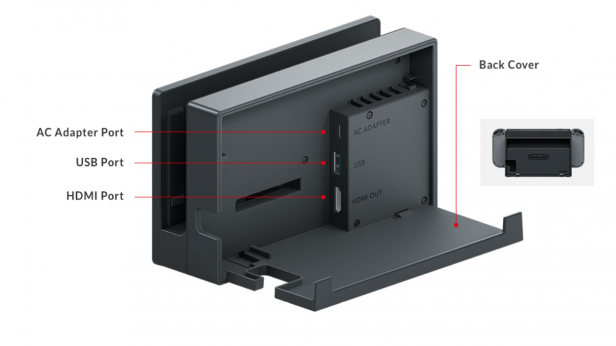
When undocked, the Switch has a 720p screen. This resolution consists of 921,600 pixels, where Full HD is 2,073,600 pixels. If you spotted that the Switch has a much slower GPU clock speed when undocked, this is the reason why. There’s a lot less work to do at 720p, so this will save on battery life.
It looks like different games will have different performance specs depending on whether they’re docked or not. For example, Zelda: Breath of the Wild is aiming for 1080p performance at 60fps. Right now, it’s at just 900p/30fps when docked, which isn’t brilliant. Expect news stories about every single Switch game launch relating to docked/undocked performance discrepancies. Oh, the joy.
Storage is another concern. With just 32GB of on-board storage compared to the up to 2TB you can get on Sony and Microsoft’s consoles, there’s not much room for media or game downloads. Nintendo’s online subscription service will include free game downloads every month, so you’ll need to keep an eye on your console to make sure you have enough room for the games.
See also: Nintendo Switch Problems and How to Solve Them
You can expand the Switch’s storage with a microSD card, and you’ll be able to install games onto it.
You’ll probably buy most of your games physically. These will come on Nintendo Game Cards, a format with a capacity of around 16GB. This is significantly smaller than the massive 50GB games you can get on the bigger consoles, but since these games will be much more stylised (less detailed) than those, it’s no surprise.
In terms of audio, there’s no high-quality optical S/PDIF port on the Switch. This isn’t an enormous problem, but is worth bearing in mind if you’re setting up the Switch as part of a high-end home cinema system.
Nintendo Switch vs PS4 and Xbox One – Exclusive Titles
After all the technical discussion above, ultimately whether you buy a Switch will be down to the games you want to play. Nintendo exclusives remain strong, including Zelda and Mario titles as well as Splatoon and dozens more besides.
Similarly, there are phenomenal exclusives on Xbox One and PS4 that might take your fancy.
Related: ARMS preview
Nintendo Switch vs PS4 and Xbox One – Final Thoughts
The Nintendo Switch is a technically fascinating console with loads of features that might take time to fulfil their potential. At £280, it will be a harder sell than the known entities of the PS4 and Xbox One, but those machines can’t do gaming on the move – a huge, huge deal for many people.
Ultimately, the Switch isn’t really designed as a straight-up rival to the PlayStation and Xbox, if only because you probably already own one of those systems. To our mind, the most compelling argument for the Switch is as a complementary console, one which adds unique functionality and a handful of tempting exclusives – namely The Legend of Zelda: Breath of the Wild – to your gaming arsenal.
For hardcore gamers, die-hard Nintendo fans, and those with long commutes, buying the Switch may be something of a no-brainer. But for the rest of us, nigh on £300 is a steep asking price for something that, in all likelihood, will live its life as a secondary system.
Buy Now: Nintendo Switch+ Mario and Rabbids Kingdom Battle Bundle for £279.99
WATCH: Best Nintendo Switch games
How do you think the Nintendo Switch compares to the PS4 and Xbox One? Let us know in the comments below.


